#Frederick II Hohenstaufen
Text
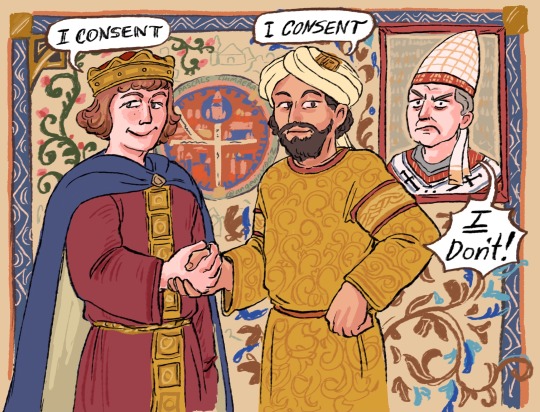
Isn't there someone you forgot to ask?
My rendition of Emperor Frederick II and Sultan al-Kāmil at the 1229 Treaty of Jaffa at the end of the sixth crusade, which was mostly negotiated in secret and negatively received but is an interesting episode
#emperor Frederick ii#Frederick ii hohenstaufen#sultan al-kamil#Pope Innocent III#Historical art#Sixth crusade#13th century#My art
60 notes
·
View notes
Text
I’m reading again Ernst Kantorowicz biography about Emperor Frederick II Hohenstaufen and I happened in one of my favourite parts, the one dedicated of course to Pier delle Vigne.

This is so huge (to me) because the author here is describing Frederick and Pier basically as the “You Don`t Know Him Like I Do 😤 “ trope to each other.
(But also: the image of a ruler and of his closest collaborator that works so good together that their plural ideas became easily one, that after eight centuries the outcomes of their partnership is still considered indivisible, you can’t understand when one finish and the other one starts etc etc).
#pier delle vigne#pier/federico#federico ii#emperor frederick ii#Frederick II Hohenstaufen#pier della vigna#Ernst Kantorowicz#King Manfred’s letters in della Vigna’s style disclose a painful discrepancy#girl?#ah yes sometimes is forgotten but after his death Pier delle Vigne was still considered a traitor BUT his style and works#were transmitted by his pupils and students - many of them remembered him fondly like Nicola da Rocca which after the fall of the Hohenstauf#dinasty saved the papers of his old master and that's to him that we have a lot of Pier de#delle Vigne surviving work#italian history#sicilian history#medieval history#13th century
9 notes
·
View notes
Text
Volti dei tre anziani della Cattedrale di Termoli

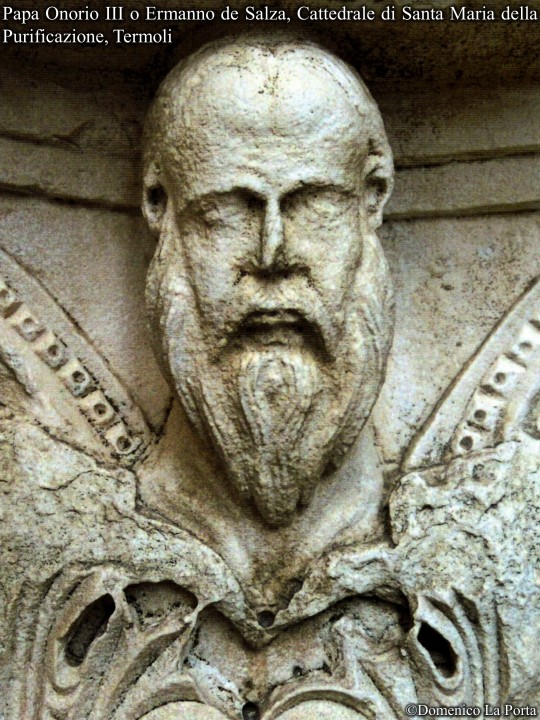

Nel lato sinistro del capitello, il consigliere e giurista di Federico II, Pier delle Vigne, mentre nel lato destro abbiamo il secondo giurista più vicino all'imperatore, Taddeo da Sessa, e nel centro, un anziano dalla lunga barba ed il volto malinconico o dolente, identificabile come il pontefice Onorio III, magister regis dell'infante Federico, oppure il terzo più importante consigliere di quest'ultimo, il gran maestro teutonico Ermanno de Salza.
Cattedrale di Santa Maria della Purificazione, Termoli (CB), prima metà del XIII secolo (1225-1235), secondo capitello del lato sinistro della facciata principale.
#storia#molise#italia#termoli#medioevo#archeologia#arte#cultura#federico ii#federico ii di svevia#italy#frederick ii#hohenstaufen#papa Onorio III#Onorio III#Ermanno de Salza#Hermann Von Salza#Pier delle Vigne#Taddeo da Sessa#art#medieval art#13th century#medieval europe#normanni#svevi#romanico#architettura#storia dell'arte#architecture#cattedrale
4 notes
·
View notes
Text

Frederick II of Hohenstaufen – De arte venandi cum avibus [On the Art of Hunting with Birds], c. 1240
104 notes
·
View notes
Text
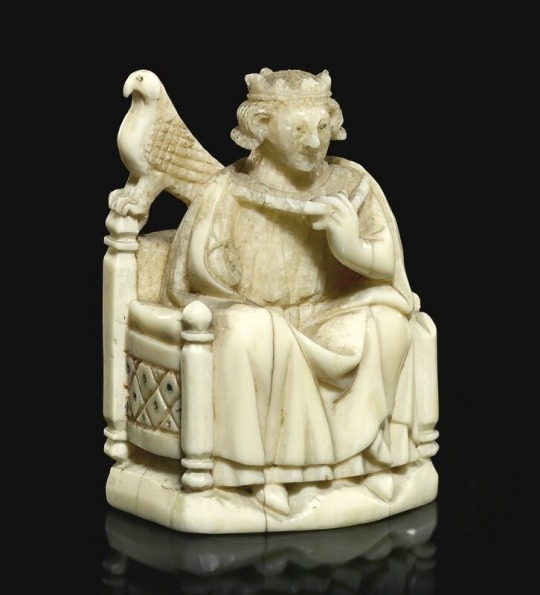
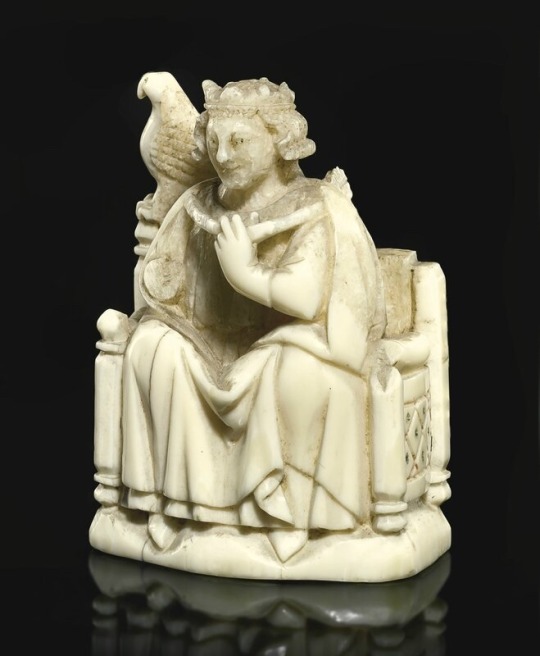
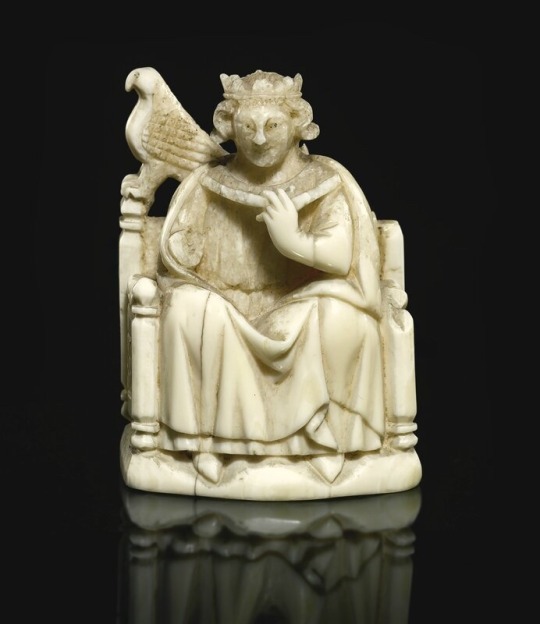
The Hohenzollern-von Hirsch chess piece. German, probably Cologne, circa 1300-1320,
Chess piece: a King, a proposed portrait of Frederick II Hohenstaufen (1194-1250).
Courtesy Alain Truong
261 notes
·
View notes
Text
THIS DAY IN GAY HISTO
based on: The White Crane Institute's 'Gay Wisdom', Gay Birthdays, Gay For Today, Famous GLBT, glbt-Gay Encylopedia, Today in Gay History, Wikipedia, and more … March 25


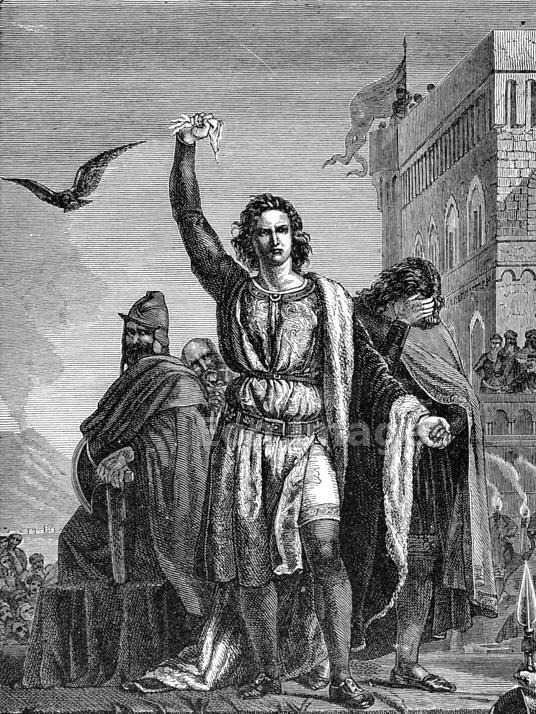
1252 – Conrad, Bavarian royalty, born (d.1268); called the Younger or the Boy, but usually known by the diminutive Conradin, was the Duke of Swabia (1254-1268, as Conrad IV), King of Jerusalem (1254-1268, as Conrad III), and King of Sicily (1254-1258 as Conrad II). He was born in Wolfstein, Bavaria, son of Conrand IV of Germany. He is sometimes known as Conrad V, though he never succeeded his father in Germany.
Conradin was the last legitimate Hohenstaufen, tafter the assassination of Conrad IV. We know little of his appearance and character except that he was "as beautiful as Absalom and spoke good Latin".
While he was still a child in Germany, his uncle Manfred made himself king of Sicily (1258), but when Manfred died eight years later, the kingdom was seized by Charles of Anjou. Conradin was persuaded to come to Italy to recover his kingdom, and, accompanied by his lover, Frederick of Baden, titular Duke of Austria, he gained the support of several Italian cities.
In the end, however, Conradin was captured by Charles, tried as a traitor and beheaded. His lover, Frederick, at his own request, was executed with him. Conradin was just 16; Frederick was 21. To this day Gay lovers make pilgrimages to the church of the monastery of Santa Maria del Carmine at Naples, where the two young men were laid to rest, together.


1479 – Grand Prince Vasily III of Moscow, (d.1533), Prince and military general. Vasily was homosexual throughout his life. He went to the extent of announcing this fact to other gay men of his time by shaving off his beard when his twenty-year marriage to his first wife was terminated - being beardless was a sort of gay password at the time.
During Vasily's second marriage, he was able to perform his conjugal duties only when an officer of his guard joined him and his wife in bed in the nude.

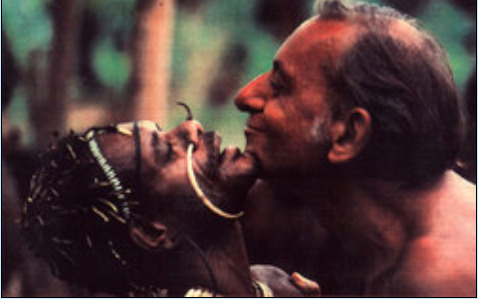
1922 – Tobias Schneebaum (d.2005) was an American artist, anthropologist, and AIDS activist. He is best known for his experiences living, and traveling among the Harakmbut people of Peru, and the Asmat people of Papua, Western New Guinea, Indonesia then known as Irian Jaya.
He was born on Manhattan's Lower East Side and grew up in Brooklyn. In 1939 he graduated from the Stuyvesant High School, moving on to the City College of New York, graduating in 1943 after having majored in mathematics and art. During World War II he served as a radar repairman in the U.S. Army.
In 1947, after briefly studying painting with Rufino Tamayo at the Brooklyn Museum of Art, Schneebaum went to live and paint in Mexico for three years, living among the Lacandon tribe. In 1955 he won a Fulbright fellowship to travel and paint in Peru. After hitch-hiking from New York to Peru, he lived with the Harakmbut people for seven months, where he slept with his male subjects and claimed to have joined the tribe in cannibalism on one occasion.
The Harakmbut treated him well. They taught him words from their language and otherwise communicated through gesture. They shared their food with him and decorated his body in red pigments. At night in their communal hut, the Arakmbut men welcomed him into a warm body pile. These entanglements often turned sexual, to Schneebaum's delight. As he would later write, he had at last found a place where people "would accept me, teach me how to live without a feeling of aloneness, teach me love and allow for my sexuality."
Until 1970 he was the designer at Tiber Press, then in 1973 he embarked on his third overseas trip, to Irian Jaya in South East Asia, living with the Asmat people on the south-western coast. He helped establish the Asmat Museum of Culture and Progress. Schneebaum would return there in 1995 to revisit a former lover, named Aipit. He recounted his journey into the jungles of Peru in the 1961 memoir Keep the River on Your Right. In 1999, he revisited both Irian Jaya and Peru for a documentary film, also titled Keep the River on Your Right.
Schneebaum spent the final years of his life in Westbeth Artists Community, an artists' commune in Greenwich Village, and died in 2005 in Great Neck, New York. He bequeathed his renowned Asmat shield collection to the Metropolitan Museum of Art in New York City and his personal papers are preserved within the Jean-Nickolaus Tretter Collection in Gay, Lesbian, Bisexual and Transgender Studies.


1942 – Richard O'Brien (born Richard Timothy Smith in Cheltenham, England) is a writer, actor, television presenter and theatre performer. He is perhaps best know known for writing the cult musical The Rocky Horror Show and for his role in presenting the popular TV show The Crystal Maze.
In addition to writing The Rocky Horror Show O'Brien also starred in its 1975 film adaptation The Rocky Horror Picture Show as the character Riff Raff. The stage show has been in almost continuous production since, and the cinematic version is one of the best known and most ardently followed cult films of all time.
In 1952, he emigrated with his family to Tauranga, New Zealand where his father had purchased a sheep farm. After learning how to ride horses, a skill which provided him with his break into the film industry as a stuntman in Carry On Cowboy, and developing a keen interest in comic books and horror films, he returned to England in 1964. Upon launching his acting career he changed his name to O'Brien — his mother's maiden name — as there was already an actor named Richard Smith.
He joined several stage productions as an actor without ever excelling or receiving critical acclaim, but that was not his primary objective. In 1972, he met director Jim Sharman who would help make his draft of a gothic-themed, schlock-horror comic-book fantasy romp into a reality. The script took O'Brien 6 months to write, Sharman suggested changing the working title They Came from Denton High to The Rocky Horror Show and the show opened in June 1973.
He became a serial bit-part actor in cult films and has appeared in notable movies such as Flash Gordon (1980), Dark City (1998) and Dungeons & Dragons (2000).
O'Brien has married twice and fathered three children. In a 2009 interview he spoke about an ongoing struggle to reconcile cultural gender roles and described himself as being transgender or possible third sex. O'Brien stated, 'There is a continuum between male and female. Some are hard-wired one way or another, I'm in between.' He expounded on this in a 2013 interview where he talked about using oestrogen for the previous decade, and that he views himself as 70% male and 30% female.


Elton John and David Furnish.
1947 – Elton John, English singer and songwriter, born; (born Reginald Kenneth Dwight) is an English pop/rock singer, composer, and pianist.
In his four decade career, John has been one of the dominant forces in rock and popular music, especially during the 1970s. He has sold more than 250 million albums, and over one hundred million singles, making him one of the most successful artists of all time. He has more than 50 Top 40 hits including seven consecutive #1 U.S. albums, 59 Top 40 singles, 16 Top 10, 4 #2 hits, and nine #1 hits. He has won five Grammy awards and one Academy Award. His success has had a profound impact on popular music and has contributed to the continued popularity of the piano in rock and roll. In 2004, Rolling Stone ranked him #49 on their list of the 100 Greatest Artists Of All Time.
In the late 1960s, John was engaged to be married to his first lover, secretary Linda Woodrow, who is mentioned in the song "Someone Saved My Life Tonight". He married German recording engineer Renate Blauel in 1984, in Darling Point, Sydney, with speculation that the marriage was a cover for his homosexuality. John had come out as bisexual in a 1976 interview with Rolling Stone, but after his divorce from Blauel in 1988 he told the magazine that he was "comfortable" being gay. Elton has a new look, and a sharp wit. "Ever since I had that interview in which I said I was bisexual," he grins, "it seems twice as many people wave at me on the streets."
In 1993, John began a relationship with Canadian David Furnish, a former advertising executive and now filmmaker. John and Furnish entered a civil partnership in 2005. They held a low-key ceremony at the Windsor Guildhall, followed by a lavish party at their Berkshire mansion, thought to have cost £1 million. Their son, Zachary Jackson Levon Furnish-John, was born to a surrogate mother in December 2010 in California. John and Furnish chose Lady Gaga, magazine editor Ingrid Sischy, and Sichy's partner Sandy Brant as Zachary's godmothers
John was inducted into the Rock and Roll Hall of Fame in 1994. He has been heavily involved in the fight against HIV-AIDS since the late 1980s and was knighted in 1998. He continues to be a champion for the LGBT social movements.


1958 – Today's the birthday of the award-winning British film and music-video director and screenwriter John Maybury. He directed the groundbreaking music video that made Sinead O'Connor a star: Nothing Compares 2U. In 2005 he was listed as one of the 100 most influential Gay and Lesbian people in Britain.
He studied at North East London Polytechnic and St Martins and designed sets for Derek Jarman's 'Jubilee', and worked with him on 'The Last of England', 'War Requiem' and 'The Tempest'.
In 1998 he produced his first full length feature Love Is the Devil: Study for a Portrait of Francis Bacon, a biopic starring Derek Jacobi and Daniel Craig (showing all in a lingering full-frontal). The film was screened in the Un Certain Regard section at the 1998 Cannes Film Festival. In 2005 he directed The Jacket with Adrien Brody and Keira Knightley. In 2008 his film The Edge of Love, a biopic on the life of Welsh poet Dylan Thomas starring Sienna Miller, Cillian Murphy, Matthew Rhys and Keira Knightley premiered. He also directed the final episode of the critically acclaimed HBO/BBC Rome series.


1962 – Thom Bierdz, openly gay American soap opera star and painter, born; Born in Kenosha, Wisconsin, this American actor is best known for his role as Phillip Chancellor III on The Young and The Restless, appearing from 1986 to 1989 and returning for one "dream sequence" in 2004.
Shortly after Thom left Y&R to pursue movie roles, his youngest brother Troy, a paranoid schizophrenic, beat their mother to death with a baseball bat. He is currently serving a life sentence in a Wisconsin prison. In May 2002, his other brother Craig committed suicide. Bierdz had devoted most of his time to painting in recent years, although he has also written a memoir entitled "Forgiving Troy."
On May 15, 2009, Bierdz re-appeared in The Young and The Restless as the mysterious character "Langley," who is eventually revealed to be Philip III, the heir to the Chancellor fortune. Phillip has been alive for the past 20 years and had faked his death after the drunk driving accident in 1989. In another revealing twist, Phillip returns to Genoa City and explains to Nina that the reason he left all those years ago is because he was gay and felt back then he would not have been accepted.
Thom has also written a memoir entitled "Forgiving Troy". In September 2009, The Human Rights Campaign at a Black Tie Gala themed "Speak Your Truth" presented Thom with their Visibility Award for his continued contributions to charity work for human rights, through his art, his acting, his writing, and his painting in the nude.
*(Hope you like my little joke!)


1979 – Lee Pace is an American actor. He is known for starring as Thranduil the Elvenking in The Hobbit trilogy and as Joe MacMillan in the AMC period drama television series Halt and Catch Fire. He has also appeared in the Marvel Cinematic Universe as Ronan the Accuser, a role he first played in Guardians of the Galaxy and reprised in Captain Marvel. He received an Emmy Award nomination for his portrayal of Ned in the ABC comedy-drama Pushing Daisies. From 2021, he stars as the galactic emperor Brother Day in the TV series adaptation of Isaac Asimov's science fiction stories Foundation.
Pace was born in Chickasha, Oklahoma. As a child, Pace spent several years in Saudi Arabia, where his father worked in the oil business; the family later moved to Houston, Texas. Pace attended Klein High School in Spring, Texas, a suburb of Houston, with actor Matt Bomer.
Pace briefly stopped attending high school to act at Houston's Alley Theatre before returning to graduate. At the Alley, he appeared in productions of The Spider's Web and The Greeks.
In 1997, he was accepted by the Juilliard School's Drama Division. While there, he was in several plays, including Romeo and Juliet as Romeo, Richard II in the title role, and Julius Caesar as Cassius. He graduated from Juilliard with a Bachelor of Fine Arts degree.
Pace first gained recognition for his role in the 2003 film Soldier’s Girl, based on real events, in which he played the central role of Calpernia Addams.
Of the role, Pace has said:
Not even my excellent training at Juilliard prepared me for my first movie role, where I played a transsexual who falls in love with a military guy in Soldier’s Girl. Here I was, this 6 feet 3 inches (1.91 m), 190 pounds (86 kg), lanky kid from Chickasha, Oklahoma, not knowing how to begin being a woman. So I saw documentaries about transsexuals, I lost twenty-five pounds, and I put on prosthetic boobs and hips to become that character. There were times I’d look in the mirror and wonder, ‘What am I doing to my life here? My dad is going to kill me!’ But the reason I went into acting was to be able to play parts as complicated and important as this one. In playing a transsexual, I got the chance to help change people’s perspective about other people, and that is a powerful thing. I’m playing a swashbuckling bandit in my next film, but I’ll always be proud of Soldier’s Girl ”.Pace's sexual orientation became a topic of public discussion after he was accidentally outed as gay by Ian McKellen, who worked with him in The Hobbit films, in 2012. McKellen's "outing" was described in the press as a blunder and an accident on his part, as Pace had never addressed the subject. In June 2018, he spoke about being a queer actor in an interview with The New York Times


1983 – Andrew Goldstein (born in Milton, Massachusetts) is the first American male team-sport professional athlete to be openly gay during his playing career. He had been a professional lacrosse goaltender for the Long Island Lizards of Major League Lacrosse. He was originally drafted by his hometown team, the Boston Cannons.
The two-time All-American at Dartmouth College in Hanover, New Hampshire, Goldstein made headlines off the field in 2005 when he was dubbed by ESPN to be "the most accomplished male, team-sport athlete in North America to be openly gay during his playing career."
Yet as Goldstein points out, "gay All-American" is a phrase that is still contradictory for some:
"'All-American' is what you think of, you know, the three kids, the white picket fence, 'All-American'. And gay does not fit into that. So it's nice for me to hear 'gay All-American,' and to think it's just the same as 'All-American.' "
He revealed his sexuality to his team after the 2003 season, and an online essay that appeared on Outsport.com elevated his story to national prominence.
It was the first session of weight lifting during the summer term of Goldstein's sophomore year when he officially came out to his team. He pulled aside senior defender Matt Nicholson and told him he had a boyfriend, Ethan.
Nicholson, who had known Ethan previously, admittedly was surprised by the revelation, but he still managed a pretty decent comeback.
"Wow, man," he said, "he's hot."
Later, in an emotional e-mail, Nicholson told Goldstein it didn't change anything.
"I'm here for you," he wrote. "I'm your teammate. I'm your defenseman, and you're my goalie."
Goldstein was touched.
Goldstein asked Nicholson to pass the word to the rest of the team. If anybody had any questions or concerns, Goldstein said, have the player come talk to him. During the first few weeks, there were some uncomfortable moments.
When the news had settled on the team, a number of Goldstein's teammates apologized. It occurred to them that, in the macho, testosterone-charged atmosphere of the lacrosse locker room, they had probably offended their teammate countless times over the seasons.
youtube
SportsCenter: "Andrew Goldstein" (8 minutes)
In 2006, Goldstein was honored by being named to the OUT 100. He also received a prestigious 2006 GLAAD Media Award for the feature entitled "Andrew Goldstein" which aired on ESPN's Sportscenter.
A biochemistry and molecular biology major at Dartmouth, Goldstein has earned his Ph.D. in biology at UCLA with a specific focus on cancer. He is now a post-doctoral researcher at UCLA. On August 2, 2013, Goldstein was inducted into the National Gay and Lesbian Sports Hall of Fame.

1993 – Idaho enacts a sex offender registration law that includes consensual sodomy.


24 notes
·
View notes
Text
Wives and Daughters of Holy Roman Emperors: Age at First Marriage
I have only included women whose birth dates and dates of marriage are known within at least 1-2 years, therefore, this is not a comprehensive list.
This list does not include women who died before their husbands were crowned Emperor. It spans between the beginning of the reign of Otto I (962 CE) and the end of the reign of Francis II (1806 CE).
The average age at first marriage among these women was 17. The sample size was 91 women. The youngest bride, Bianca Maria Sforza, was just 2 years old when she wed her first husband, who was himself 9. The oldest bride, Constance of Sicily, was 32 years old.
Adelaide of Italy, wife of Otto I, HRE: age 15 when she married Lothair II, King of Italy, in 947 CE
Liutgarde of Saxony, daughter of Otto I, HRE: age 15 when she married Conrad the Red, Duke of Lorraine, in 947 CE
Theophanu, wife of Otto II, HRE: age 17 when she married Otto in 972 CE
Cunigunde of Luxembourg, wife of Henry II, HRE: age 24 when she married Henry in 999 CE
Gisela of Swabia, wife of Conrad II, HRE: age 12 when she married Brun I of Brunswick in 1002 CE
Agnes of Poitou, wife of Henry III, HRE: age 18 when she married Henry in 1043 CE
Matilda of Germany, daughter of Henry III, HRE: age 11 when she married Rudolf of Rheinfelden in 1059 CE
Judith of Swabia, daughter of Henry III, HRE: age 9 when she married Solomon, King of Hungary in 1063 CE
Bertha of Savoy, wife of Henry IV, HRE: age 15 when she married Henry in 1066 CE
Agnes of Waiblingen, daughter of Henry IV, HRE: age 14 when she married Frederick I, Duke of Swabia in 1086 CE
Empress Matilda, wife of Henry V, HRE: age 12 when she married Henry in 1114 CE
Beatrice I, Countess of Burgundy, wife of Frederick I, HRE: age 13 when she married Frederick in 1156 CE
Beatrice, daughter of Frederick I, HRE: age 10 when she married Guillaume II, Count of Chalon in 1173 CE
Constance, Queen of Sicily, wife of Henry IV, HRE: age 32 when she married Henry IV in 1186 CE
Beatrice of Swabia, first wife of Otto IV, HRE: age 14 when she married Otto in 1212 CE
Maria of Brabant, second wife of Otto IV, HRE: age 24 when she married Otto in 1214 CE
Constance of Aragon, first wife of Frederick II, HRE: age 19 when she married Emeric of Hungary in 1198 CE
Isabella II of Jerusalem, second wife of Frederick II, HRE: age 13 when she married Frederick in 1225 CE
Isabella of England, third wife of Frederick II, HRE: age 21 when she married Frederick in 1235 CE
Margaret of Sicily, daughter of Frederick II, HRE: age 14 when she married Albert II, Margrave of Meissen in 1255 CE
Anna of Hohenstaufen, daughter of Frederick II, HRE: age 14 when she married John III Doukas Vatatzes in 1244 CE
Marie of Luxembourg, daughter of Henry VII, HRE: age 18 when she married Charles IV of France in 1322 CE
Beatrice of Luxembourg, daughter of Henry VII, HRE: age 13 when she married Charles I of Hungary in 1318 CE
Margaret II, Countess of Hainaut, wife of Louis IV, HRE: age 13 when she married Louis in 1324 CE
Matilda of Bavaria, daughter of Louis IV, HRE: age 10 when she married Frederick II, Margrave of Meissen in 1323 CE
Beatrice of Bavaria, daughter of Louis IV, HRE: age 12 when she married Eric XII of Sweden in 1356 CE
Anna von Schweidnitz, wife of Charles IV, HRE: age 14 when she married Charles in 1353 CE
Elizabeth of Pomerania, wife of Charles IV, HRE: age 16 when she married Charles in 1378 CE
Margaret of Bohemia, daughter of Charles IV, HRE: age 7 when she married Louis I of Hungary in 1342 CE
Catherine of Bohemia, daughter of Charles IV, HRE: age 14 when she married Rudolf IV, Duke of Austria in 1356 CE
Elisabeth of Bohemia, daughter of Charles IV, HRE: age 8 when she married Albert III, Duke of Austria in 1366 CE
Anne of Bohemia, daughter of Charles IV, HRE: age 16 when she married Richard II of England in 1382 CE
Margaret of Bohemia, daughter of Charles IV, HRE: age 8 when she married John III, Burgrave of Nuremburg in 1381 CE
Barbara of Cilli, wife of Sigismund, HRE: age 13 when she married Sigismund in 1405 CE
Elizabeth of Luxembourg, daughter of Sigismund, HRE: age 13 when she married Albert II of Germany in 1422 CE
Eleanor of Portugal, wife of Frederick III, HRE: age 18 when she married Frederick in 1452 CE
Kunigunde of Austria, daughter of Frederick III, HRE: age 22 when she married Albert IV, Duke of Bavaria in 1487 CE
Bianca Maria Sforza, wife of Maximilian I, HRE: age 2 when she married Philibert I, Duke of Savoy in 1474 CE
Margaret of Austria, daughter of Maximilian I, HRE: age 17 when she married John, Prince of Asturias in 1497 CE
Barbara von Rattal, daughter of Maximilian I, HRE: age 15 when she married Siegmund von Dietrichstein in 1515 CE
Dorothea of Austria, daughter of Maximilian I, HRE: age 22 when she married Johan I of East Frisia in 1538 CE
Isabella of Portugal, wife of Charles V, HRE: age 23 when she married Charles in 1526 CE
Maria of Austria, daughter of Charles V, HRE: age 20 when she married Maximilian II, HRE in 1548 CE
Joanna of Austria, daughter of Charles V, HRE: age 17 when she married John Manuel, Prince of Portugal in 1552 CE
Margaret of Parma, daughter of Charles V, HRE: age 14 when she married Alessandro de’ Medici, Duke of Florence, in 1536 CE
Elizabeth of Austria, daughter of Ferdinand I, HRE: age 16 when she married Sigismund II Augustus of Poland in 1543 CE
Anna of Austria, daughter of Ferdinand I, HRE: age 17 when she married Albert V, Duke of Bavaria in 1546 CE
Maria of Austria, daughter of Ferdinand I, HRE: age 15 when she married William of Julich-Cleves-Berg in 1546 CE
Catherine of Austria, daughter of Ferdinand I, HRE: age 16 when she married Francesco III Gonzaga in 1559 CE
Eleanor of Austria, daughter of Ferdinand I, HRE: age 27 when she married William I, Duke of Mantua in 1561 CE
Barbara of Austria, daughter of Ferdinand I, HRE: age 26 when she married Alfonso II d’Este in 1565 CE
Joanna of Austria, daughter of Ferdinand I, HRE: age 18 when she married Francesco I de’ Medici in 1565 CE
Anna of Austria, daughter of Maximilian II, HRE: age 21 when she married Philip II of Spain in 1570 CE
Elisabeth of Austria, daughter of Maximilian II, HRE: age 16 when she married Charles IX of France in 1570 CE
Anna of Tyrol, wife of Matthias, HRE: age 26 when she married Matthias in 1611 CE
Eleonora Gonzaga the Elder, wife of Ferdinand II, HRE: age 24 when she married Ferdinand in 1622 CE
Maria Anna of Austria, daughter of Ferdinand II, HRE: age 25 when she married Maximilian I, Elector of Bavaria in 1635 CE
Cecilia Renata of Austria, daughter of Ferdinand II, HRE: age 26 when she married Władysław IV of Poland in 1637 CE
Maria Anna of Spain, wife of Ferdinand III, HRE: age 25 when she married Ferdinand in 1631 CE
Maria Leopoldine of Austria, wife of Ferdinand III, HRE: age 16 when she married Ferdinand in 1648 CE
Eleonora Gonzaga the Younger, wife of Ferdinand III, HRE: age 21 when she married Ferdinand in 1651 CE
Mariana of Austria, daughter of Ferdinand III, HRE: age 15 when she married Philip IV of Spain in 1649 CE
Eleonore of Austria, daughter of Ferdinand III, HRE: age 17 when she married Michael I of Poland in 1670 CE
Maria Anna Josepha of Austria, daughter of Ferdinand III, HRE: age 24 when she married Johann Wilhelm II, Elector Palatine in 1678 CE
Margaret Theresa of Spain, wife of Leopold I, HRE: age 15 when she married Leopold in 1666 CE
Claudia Felicitas of Spain, wife of Leopold I, HRE: age 20 when she married Leopold in 1673 CE
Eleonore Magdalene of Neuberg, wife of Leopold I, HRE: age 21 when she married Leopold in 1676 CE
Maria Antonia of Austria, daughter of Leopold I, HRE: age 16 when she married Maximilian II Emanuel, Elector of Bavaria in 1685 CE
Maria Anna of Austria, daughter of Leopold I, HRE: age 25 when she married John V of Portugal in 1708 CE
Wilhelmine Amalie of Brunswick, wife of Joseph I, HRE: age 26 when she married Joseph in 1699 CE
Maria Josepha of Austria, daughter of Joseph I, HRE: age 20 when she married Augustus III of Poland in 1719 CE
Maria Amalia of Austria, daughter of Joseph I, HRE: age 21 when she married Charles VII, HRE in 1722 CE
Elisabeth Christine of Brunswick, wife of Charles VI, HRE: age 17 when she married Charles in 1708 CE
Maria Theresa of Austria, daughter of Charles VI, HRE: age 19 when she married Francis I, HRE in 1736 CE
Maria Anna of Austria, daughter of Charles VI, HRE: age 26 when she married Charles Alexander of Lorraine in 1744 CE
Maria Antonia of Bavaria, daughter of Charles VII, HRE: age 23 when she married Frederick Christian, Elector of Saxony in 1747 CE
Maria Anna Josepha of Bavaria, daughter of Charles VII, HRE: age 20 when she married Louis George of Baden-Baden in 1755 CE
Maria Josepha of Bavaria, daughter of Charles VII, HRE: age 26 when she married Joseph II, HRE in 1765 CE
Maria Christina, daughter of Francis I, HRE: age 24 when she married Albert Casimir, Duke of Teschen in 1766 CE
Maria Amalia, daughter of Francis I, HRE: age 23 when she married Ferdinand I, Duke of Parma in 1769 CE
Maria Carolina, daughter of Francis I, HRE: age 16 when she married Ferdinand IV & III of Sicily in 1768 CE
Maria Antonia, daughter of Francis I, HRE: age 14 when she married Louis XVI of France in 1770 CE
Maria Josepha of Bavaria, wife of Joseph II, HRE: age 26 when she married Joseph in 1765 CE
Maria Luisa of Spain, wife of Leopold II, HRE: age 19 when she married Leopold in 1764 CE
Maria Theresa of Austria, daughter of Leopold II, HRE: age 20 when she married Anthony of Saxony in 1787 CE
Maria Clementina of Austria, daughter of Leopold II, HRE: age 20 when she married Francis I of Sicily in 1797 CE
Maria Theresa of Naples, wife of Francis II, HRE: age 18 when she married Francis in 1790 CE
Marie Louise, daughter of Francis II, HRE: age 19 when she married Napoleon I of France in 1810 CE
Maria Leopoldina, daughter of Francis II, HRE: age 20 when she married Pedro I of Brazil and IV of Portugal in 1817 CE
Clementina, daughter of Francis II, HRE: age 18 when she married Leopold of Salerno in 1816 CE
Marie Caroline, daughter of Francis II, HRE: age 18 when she married Frederick Augustus of Saxony in 1819 CE
35 notes
·
View notes
Photo

“Augustalis” of Frederick II Hohenstaufen (r. 1215–50). 1230–50. Credit line: Gift of C. Ruxton Love Jr., 1967 https://www.metmuseum.org/art/collection/search/468737
#aesthetic#art#abstract art#art museum#art history#The Metropolitan Museum of Art#museum#museum photography#museum aesthetic#dark academia
6 notes
·
View notes
Photo



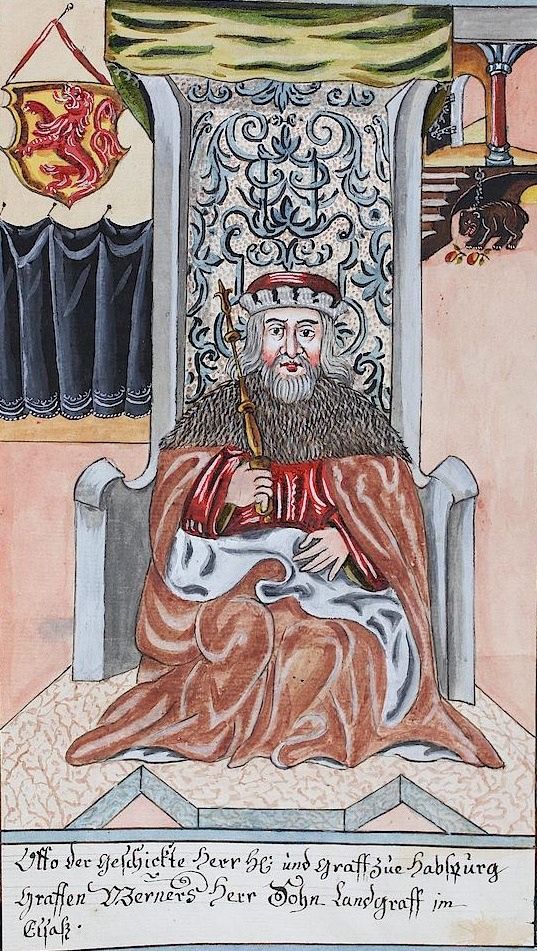


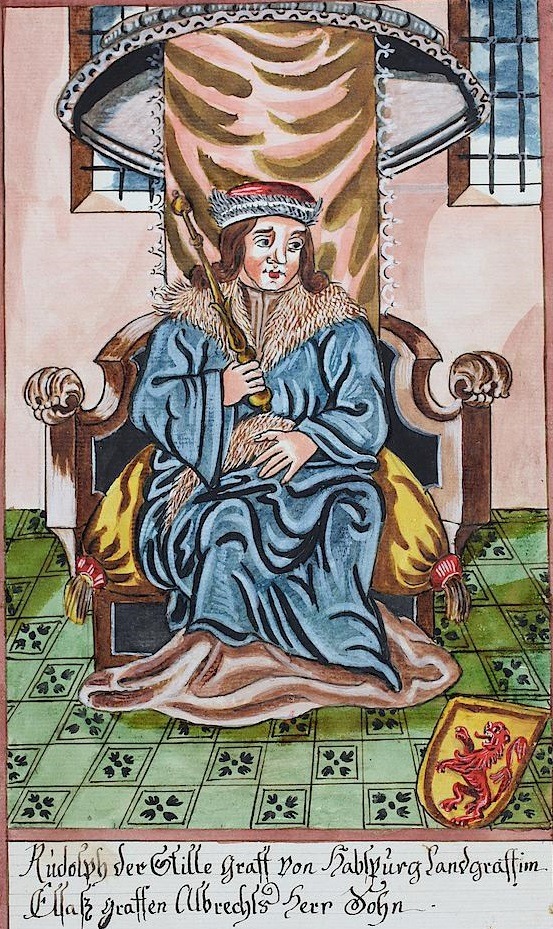
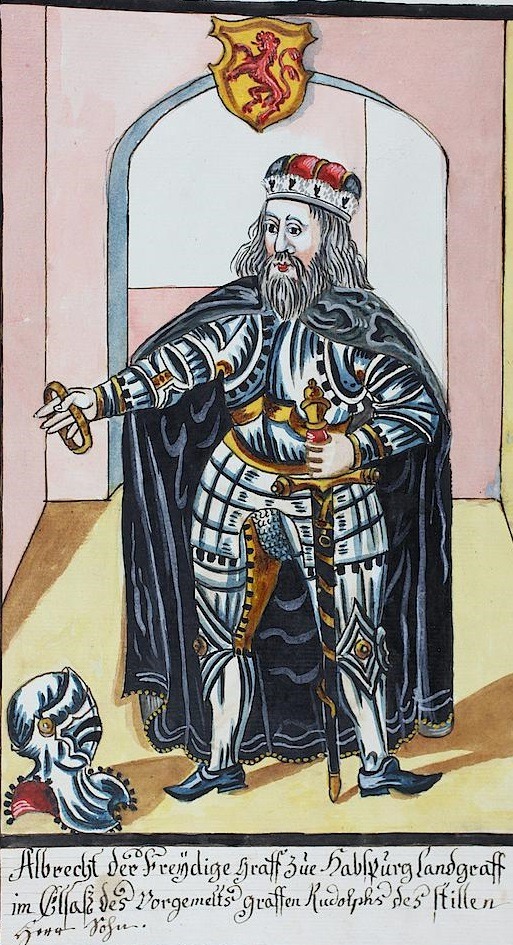
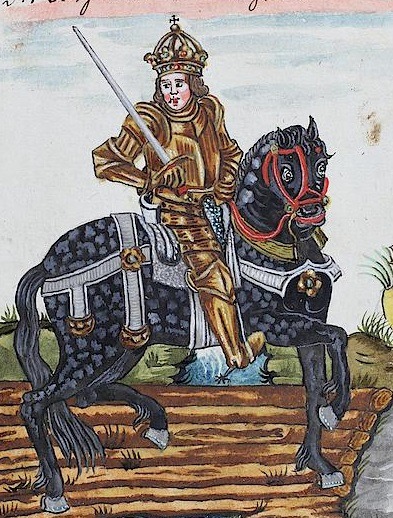
List of Monarchs: The House of Habsburg.
1. Guntram the Rich (920-973; the progenitor of the House of Habsburg and the House of Zähringen). Guntram possessed lands in Alsace and in Breisgau, from Vogesen to Kaiserstuhl and the Black Forest.
2. Radbot of Klettgau (c. 985 – 1045). He was Graf (Count) of the county of Klettgau. He built Habsburg Castle.
3. Werner I, Count of Klettgau (c. 1025/1030-1096). Sometimes called Werner the Pious. He had two sons: Otto II, and Albert II.
4. Otto II, Count of Habsburg (d. 1111). Graf (Count) of Habsburg and one of the founding members of the Habsburg family.
5. Werner II, Count of Habsburg (d.1167). He was the great-great-grandfather of King Rudolph I of Germany.
6. Albert III, Count of Habsburg (d. 1199; also known as Albert the Rich). Like his father, he was a loyal supporter of the Imperial House of Hohenstaufen.
7. Rudolf II, Count of Habsburg (Rudolph the Kind; d. 1232).
8. Albert IV, Count of Habsburg (Albert the Wise; 1188-1239). On the death of his father in 1232, he divided the family estate with his brother Rudolf III, retaining the ancestral seat of Habsburg Castle. A follower of Emperor Frederick II of Hohenstaufen, he took part in the Barons' Crusade of 1239 with King Theobald I of Navarre and died near Ashkelon.
9. Rudolf I of Germany (1218-1291).
#Chroniken der Habsburger der Zähringer und der Stadt Freiburg#german aristocracy#haus habsburg#house of habsburg#österreich#guntram the rich#rabdot of klettgau#list of monarchs#graf von habsburg#habsburg#herzogtum österreich#heiliges römisches reich#count of habsburg#House of Zähringen#Zähringer#full length portrait#werner of klettgau#otto ii of habsburg#werner ii of habsburg#albert iii of habsburg#rudolf ii of habsburg#albert iv of habsburg#in armour#full-length portrait
8 notes
·
View notes
Photo

THE DESCRIPTION OF SAINT ELIZABETH OF HUNGARY
The Symbol of Christian Charity and Patron of Hungary
Feast Day: November 17
"As in heaven, Your will is punctually performed, so may it be done on earth by all creatures, particularly in me and by me."
Elizabeth of Thuringia, a symbol of Christian charity, an early member of the Third Order of St. Francis and is today honored as its patroness, the patroness of Hungary, the Archdiocese of Bogotá in Colombia, and of the Archdiocese of Jaro in Iloilo, was born on July 7, 1207 in Pozsony, Kingdom of Hungary (modern-day Bratislava, Slovakia), and is the daughter of King Andrew II of Hungary (Andrew of Jerusalem) and Gertrude of Merania, who was killed at the hands of the nobles led by Peter, son of Töre. Her mother's sister was Hedwig of Andechs, the wife of Duke Heinrich I of Silesia. Her ancestry included many notable figures of European royalty, going back as far as Vladimir the Great of the Kievan Rus'.
According to a different tradition, Elizabeth lived in the Castle of Posonium until the age of four. After she was brought to the court of the rulers of Thuringia in central Germany, Elizabeth was married at a young age in 1221 to Louis IV, Landgrave of Thuringia (Ludwig IV), the son of Hermann I, giving birth to three children, and a future union which would reinforce political alliances between the two families. She was raised by the Thuringian court and would have been familiar with the local language and culture. That same year, Louis was enthroned as landgrave. Their marriage appears to have been happy.
Her husband was fascinated by her charm and holiness. Whenever he went back from an official trip, he would always give her a present; and used to say that he would rather cast away a mountain of gold than give her up. In 1223, Franciscan friars arrived, and the teenage Elizabeth not only learned about the ideals of Francis of Assisi, but started to live them. Louis was not upset by his wife's charitable efforts, believing that the distribution of his wealth to the poor would bring eternal reward; he is venerated in Thuringia as a saint, though he was never canonized by the church.
It was also about this time that the priest and later inquisitor Konrad von Marburg gained considerable influence over Elizabeth when he was appointed as her confessor and later, spiritual father. When floods, famine and plague wrought havoc in Thuringia in the spring of 1226, Louis, a staunch supporter of the Hohenstaufen Frederick II, the Holy Roman Emperor, represented Frederick II at the Imperial Diet held in Cremona. Elizabeth assumed control of affairs at home and distributed alms in all parts of their territory, even giving away state robes and ornaments to the poor.
A few years later, Elizabeth's life begins to irrevocably changed forever. On September 11, 1227, when her husband Louis, en route to join the Sixth Crusade, died of a fever in Otranto at the age of just 26 years old, just a few weeks before the birth of her daughter Gertrude. Upon hearing the news of her husband's death and Louis' body returned to Germany, she reportedly said and cried: 'He is dead. He is dead. It is to me as if the whole world died today!'
His remains were returned to Elizabeth in 1228 and entombed at the abbey of Reinhardsbrunn. After Louis' death, his brother, Henry Raspe, assumed the regency during the minority of Elizabeth's eldest child, Hermann. After bitter arguments over the disposal of her dowry—a conflict in which Konrad was appointed as the official Defender of her case by Pope Gregory IX—Elizabeth left the court at Wartburg and moved to Marburg in Hesse.
Following her husband's death, Elizabeth made solemn vows to Konrad similar to those of a nun. These vows included celibacy, as well as complete obedience to Konrad as her confessor and spiritual director. Konrad's treatment of Elizabeth was extremely harsh, and he held her to standards of behavior which were almost impossible to meet. Among the punishments he is alleged to have ordered were physical beatings; he also ordered her to send away her three children. Her pledge to celibacy proved a hindrance to her family's political ambitions. Elizabeth was more or less held hostage at Pottenstein, the castle of her uncle, Bishop Ekbert of Bamberg, in an effort to force her to remarry. Elizabeth, however, held fast to her vow, even threatening to cut off her own nose so that no man would find her attractive enough to marry.
Sophie of Thuringia, Elizabeth's second child who will later on becoming one of the figures in the War of the Thuringian Succession and founder of the Brabant dynasty of Hesse, married Henry II, Duke of Brabant, and was the ancestress of the Landgraves of Hesse. Elizabeth's third and youngest child, Gertrude of Altenberg, was born several weeks after the death of her father; she became abbess of the monastery of Altenberg Abbey, Hesse near Wetzlar.
Thereafter, Elizabeth entered the Third Order of St. Francis (Secular Franciscan Order) in 1228, and promised never to marry again. Elizabeth spent her final years attending to the sick at the hospital of Marburg, which she had built, and supporting hundreds of poor people.
Perhaps Elizabeth is best known for her miracle of the roses. While taking bread to the poor in secret, she met her husband Ludwig on a hunting party. Ludwig, to quell suspicions of the gentry that she was stealing treasure from the castle, asked her to reveal what was hidden under her cloak. In that moment, her cloak fell open and a vision of white and red roses could be seen, which proved to Ludwig that God's protecting hand was at work. According to the Vitae, Louis was never troubled by her charity and always supported it. In some versions of this story, her brother-in-law, Heinrich Raspe, questions her. Hers is one of many miracles that associate Christian saints with roses.
Her health started to declined, and died on November 17, 1231 in Marburg, Landgraviate of Thuringia, Holy Roman Empire (modern-day Hesse, Germany). She was just only 24 years old. Elizabeth's popularity and legacy on caring of the poor was so great resulted in her canonization as a saint on May 27, 1235 in Perugia, Italy by Pope Gregory IX. There are two major shrines in her honor - in Košice, Slovakia and in Marburg, Germany.
Konrad commented these words: 'In spite of her many active works for the sick and the poor. I have seldom seen a more contemplative woman.'
#random stuff#catholic#catholic saints#elizabeth of hungary#elizabeth of thuringia#franciscans#secular franciscan order#hungary
10 notes
·
View notes
Text
The secular state had existed long before the times of Machiavelli. One of the earliest examples of a complete secularization of political life is the state founded by Frederick II in the south of Italy; and this state had been created three hundred years before Machiavelli wrote his book. It was an absolute monarchy in the modern sense; it had emancipated itself from any influence of the Church. The officials of this state were not clerics but laymen. Christians, Jews, Saracens had an equal share in the administration; nobody was excluded for merely religious reasons. At the court of Frederick II a discrimination between sects, between nations or races was unknown. The paramount interest was that of the secular, the "earthly" state.
That was an entirely new fact, a fact that had no equivalent in medieval civilization. But this fact had not yet found a theoretical expression and justification. Frederick II was always regarded as an arch heretic. He was twice excommunicated by the Church. Dante, who felt a great personal admiration for him and saw in him the very model of a great monarch, nevertheless condemned him in his Inferno to the flaming sepulchers of the heretics. The Lawbook of Frederick II has been styled "The Birth Certificate of Modern Bureaucracy." Yet although modem in his political actions Frederick was by no means modern in his thoughts. When he speaks about himself and about the origin of his empire he speaks not as a skeptic or heretic but as a mystic. He always claims an immediate personal relation to God. It is this personal relation that makes him entirely independent of all ecclesiastic influences and demands. As his biographer describes his thoughts and feelings,
divine Providence had singled him out, him only, and elevated him directly to the throne, and the marvel of her grace had enveloped the last of the Hohenstaufens in a mist of magic glory far beyond that of any other prince, far from the ken of the profane. The purposeful active Foresight of God did not enshroud the Emperor but revealed herself in him as the highest Reason: ''Leader in Reason's path" he has been called.
To Machiavelli all such mystical conceptions had become entirely unintelligible.
0 notes
Text

The Castel del Monte is a 13th century Italian castle built by the Holy Roman Emperor, Frederick II of Hohenstaufen, located in the hamlet of the same name, part of the municipality of Andria, 70 km west of Bari , in Puglia.
1 note
·
View note
Text
Sicily: An Island at the Crossroads of History. Ch. 7- The Vespers
The Sicilian Vespers led to the ousting of the French as rulers of Sicily and the installation of the Spaniards as rulers.
When Frederick II of the Hohenstaufen house died in 1250, Sicily sank back into chaos and confusion. (yeah, you're going to read that a LOT during this history recap) The barons took over, each fighting to enrich himself and grab as much as possible. (oh, you'll read THAT a lot too) Frederick's son Conrad was crowned emperor in Germany, but was stuck there, so Fred's bastard son Manfred was entrusted with control of Sicily and southern Italy. Pope Innocent IV didn't think bastard sons ought to be ruling anything and suggested Manfred turn control of the kingdom over to someone else... the someone else just happening to be... himself, the Pope. Manfred declined the offer and the Pope excommunicated him altogether. Innocent then declared someone else King, but everyone else just sort of ignored it.
Manfred was, I hear, an astonishingly good-looking man, intelligent, learned, and had devastating charm. Bastard, indeed! By 1258, Manfred, using such abilities as nature had endowed him with, had convinced the Sicilian barons to proclaim him King.
In the meantime, another daughter of Frederick, Constance, married Peter, heir to the throne of Aragon.
The successor Pope to Innocent, however, Urban IV, had not given up on puppeteering in Sicily, and named Charles of Anjou as the man who should be king of Sicily. Charles was cold, cruel, and vastly ambitious, and recognized an opportunity when he saw one. He was crowned King of Sicily in Rome in 1266 by Urban's successor, Clement IV. Charles then invaded and chased out Manfred.
With this event, the Hohenstaufen line, and Sicily's golden age, was truly ended.
The Angevin (Anjou family) line showed little interest in Sicily, concentrating more attention on the mainland, but the Sicilians weren't so easy to ignore. They revolted in 1267, and were promptly put back into place. But the severity of the repression left a lingering resentment. Administration of the island was heavy-handed, with landowners needing to prove their ownership. This was difficult for many and if it wasn't done satisfactorily, the land was confiscated and handed out to the new King's friends, all Frenchmen. In what would become a recurring theme, the Sicilians lost out.
In general, Sicily remained neglected, and the Sicilians themselves could only conclude that they belonged to an obscure and unimportant province that their ruler could not be bothered to care about.
The Sicilian Vespers
Here we find one John of Procida. A native of Salerno, he had been the personal physician of Frederick when he died. He appealed to Peter of Aragon to overthrow the Angevins. By 1282, the Angevins were pretty thoroughly detested, both for the severity of their taxation and their general arrogance. The incident that precipitated John of Procida's call to overthrow the Angevins was what has come to be called the Sicilian Vespers. When a drunk French sergeant hit on a Sicilian woman on March 30, 1282 as the bells were ringing for Vespers, her husband's pent-up anger boiled over into beating the sergeant, which boiled over to a murder. The Sicilian crowd's anger then boiled over and the murder led to a riot, the riot to a massacre, and by morning, 2000 French were dead. Ya gotta be careful about riling up Sicilians. The rising spread and on August 30, Peter of Aragon and his army landed at the far northwestern city of Trapani.
By September, Charles was driven back to the northeastern corner of the island at Messina and was forced to recognize that the Spanish conquest was basically a done-deal.
But Charles was a stubborn bastard and refused to recognize the legitimacy, and actually challenged Peter to settle up mano a mano in a duel. Charles being 55, and Peter only 40, they decided it would be more fair that each would be accompanied by 100 knights. The day was set, but they forgot to set a particular time.
In a comic scenario, the "fight" went something like this: Peter showed up early in the day, and finding no French, declared them cowards and himself the victor by forfeiture. Later in the day, the French showed up and finding no Spaniards, declared the Spaniards cowards and themselves the victors by forfeiture. I guess they at least saved face and lives this way.
But neither side giving an inch, the Regno was split with Charles remaining King of "Sicily" in Naples, and Peter calling himself king of Sicily in Palermo. This is the initiation of "The Two Sicilies".
Charles died in 1285. He had neglected Sicily. The Sicilians had pissed him off with their stubborn rebellion, and he had become bored with them, considering them poor, unprofitable, and therefore useless to him. Moreover, he thought they were a mongrel race of Latin, Greek and Arab, and therefore not to be taken seriously as a people.
Charles II was the heir, but he was being held in prison. The Angevin Kings in France still wished to recover Sicily, and the Papacy was looking after its own prestige, having granted Sicily to the Angevins.
Sicilians, on the other hand, preferred Spanish rule, but this had a consequence: it cut them off from Naples, AND... the burgeoning Italian renaissance, which would subsequently largely pass over Sicily.
The Aragonese, James "the Just" was proclaimed King of Sicily in 1286. He sought Pope Honorius' blessing and was promptly rewarded for his efforts with excommunication. Honorius then, to add injury to insult, ordered an invasion of Sicily in 1287... which was a disaster.
A number of years passed in which the decisions about who would govern/rule Sicily were made without any concern for the Sicilians themselves. But this was so standard, and would continue to be so, that most of the history of Sicily is really the history of decisions about its government made elsewhere. The machinations behind the scenes are byzantine, and frankly, have little to do with Sicily, so I'm not going to bother to even write them down here.
In 1301, the treaty of Caltabellota was signed: The Angevins would withdraw from Sicily, and Frederick would call himself King of Trinacria (the ancient Greek name for Sicily) rather than King of Sicily, so that the Angevins could still call themselves kings of Sicily. This is a prime example of European monarchy BS, so that each could feel a little less butt-hurt be the loss of land, by retaining a title.
The Sicilians themselves didn't care too much about which of these foreigners called themselves whatever, as long as said foreigners didn't inflict themselves on the island itself. The Sicilians had suffered a lot since the Vespers 20 years prior, but they were steadfast on this one point: they would not accept French rule.
1 note
·
View note
Text
Federico II di Svevia, Castello di Monte San Giovanni Campano.

Opera della prima metà del XIII secolo.
#italia#medioevo#storia#archeologia#arte#cultura#federico ii#federico ii di svevia#Monte San Giovanni Campano#frederick ii#hohenstaufen#svevia#italy#history#storia dell'arte#art#medieval art#13th century#architettura#architecture
3 notes
·
View notes
Text
Better things to do than scavenging info on LB7 given *gestures at all the nonsense*:
re-reading for the 6th? 7th? time Louis De Wohl's two books featuring a Frederick II Hohenstaufen with the characterization of an absolute menace.
#and if you squint your eyes enough there's SOMETHING going on with the count of Vandria#technically both books are novelitazions of lives of saints and they're very well done that way#but i love de wohl's federico and most of my rereads are for his scenes and his scenes alone#here's another historical figure i'd never trust type moon with. not him and not the velitrae quartet
1 note
·
View note
Photo

Survey of the thirteenth century
As to Dante himself, it is not easy to place him in a survey of the thirteenth century. In actual date and in typical expression he belongs to it, and yet he does not belong to it. The century itself has a transitional, an ambiguous character. And Dante, like it, has a transitional and double office. He is the poet, the prophet, the painter of the Middle Ages. And yet, in so many things, he anticipates the modern mind and modern art. In actual date, the last year of the thirteenth century is the ‘ middle term ’ of the poet’s life, his thirty-fifth year. Some of his most exquisite work was already produced, and his whole mind was grown to maturity. On the other hand, every line of the Divine Comedy was actually written in the fourteenth century, and the poet lived in it for twenty years.
Nor was the entire vision complete until near the poet’s death in 1321. In spirit, in design, in form, this great creation has throughout this double character. By memory, by inner soul, by enthusiasm, Dante seems to dwell with the imperial chiefs of Hohenstaufen, with Francis and Dominic, Bernard and Aquinas. He paints the Catholic and Feudal world; he seems saturated with the Catholic and Feudal sentiment. And yet he deals with popes, bishops, Church, and conclaves with the audacious intellectual freedom of a Paris dialectician or an Oxford doctor.
Between the lines of the great Catholic poem we can read the death-sentence of Catholic Church and Feudal hierarchy. Like all great artists, Dante paints a world which only subsisted in ideal and in memory, just as Spenser and Shakespeare transfigured in their verse a humanistic and romantic society such as had long disappeared from the region of fact. And for this reason, and for others, it were better to regard the sublime Dies Irce, which the Florentine wanderer chanted in his latter years over the grave of the Middle Ages, as belonging in its inner spirit to a later time, and as being in reality the dawn of modern poetry sofia sightseeing.
In Dante, as in Giotto
In Dante, as in Giotto, in Frederick II., in Edward I., in Roger Bacon, we may hear the trumpet which summoned the Middle Ages into the modern world. The true spirits of the thirteenth century, still Catholic and Feudal, are Innocent HI., St. Francis, Stephen Langton, Grossetete, Aquinas, Bonaventura, and Albert of Cologne; Philip Augustus, St. Louis, the Barons of Runnymede, and Simon de Montfort; the authors of the Golden Legend and the Catholic Hymns, the Doctors of Paris, Oxford, and Bologna; the builders of Amiens, Notre Dame, Lincoln, and Westminster.
The movement known as the Revolution of 1789 was a transformation — not a convulsion; it was constructive even more than destructive; and if it was in outward manifestation a chaotic revolution, in its inner spirit it was an organic evolution. It was a movement in no sense local, accidental, temporary, or partial; it was not simply, nor even mainly, a political movement. It was an intellectual and religious, a moral, social, and economic movement, before it was a political movement, and even more than it was a political movement.
If it is French in form, it is European in essence. It belongs to modem history as a whole quite as much as to the eighteenth century in France. Its germs began centuries earlier than the generation of 1789, and its activity will long outlast the generation of 1889. It is not an episode of frenzy in the life of a single nation. In all its deeper elements it is a condensation of the history of mankind, a repertory of all social and political problems, the latest and most complex of all the great crises through which our race has passed.
0 notes